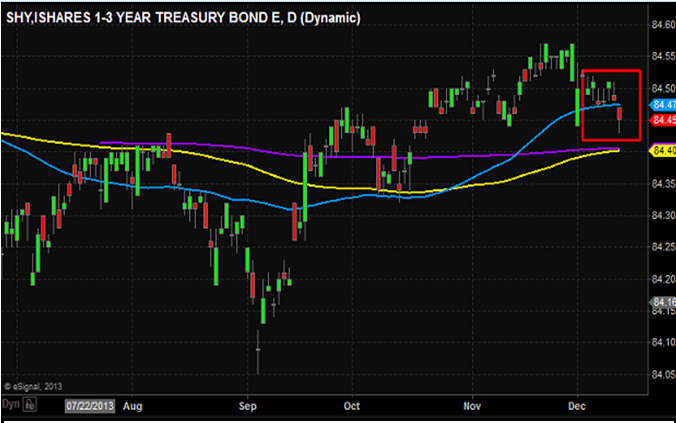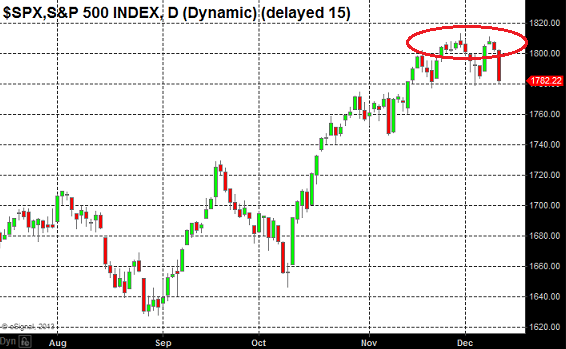The Economy: A Look Back and What’s Ahead (12.16.13)
Last Week
There was very little economic data released last week, and economically the focus was on trying to “game” the chances of the Federal Open Market Committee announcing a plan to taper QE after their meeting this week.
The two major pieces of data (retail sales and jobless claims) we received last week generated mixed signals. Positively, retail sales beat expectations, and the important “control” group—which excludes automobile, gasoline and building-material purchases—continued to advance, rising 0.53% in November.
This uptick in retail sales came at a good time, as concerns about the consumer linger, especially given many retailers’ unenthusiastic commentary on the holiday shopping season. In fact, the resilient consumer (and stronger retail sales) resulted in many analysts and strategists upping their Q4 GDP estimates, as Personal Consumption Expenditures (i.e., consumer spending) are now expected to be stronger than originally thought.
The retail sales beat was the economic “highlight” of the week, and from a WWFD (What Will the Fed Do) standpoint, it very slightly upped the chances of a taper this week. However, it certainly won’t be the deciding factor.
On the flipside, jobless claims saw a jump of 68K, to 368K, as statistical errors thanks to Thanksgiving and other factors were worked out. That number was obviously a disappointment vs. expectations, but weekly claims have been so volatile lately that many people are discounting the adjustment. And, most (including me) expect claims to move south toward the lower-300K range, where it’s been since August.
However, the most-important economic news of last week (both for the economy and with regard to WWFD) came from Washington, where a two-year budget deal was struck and passed by the House.
From a market standpoint, the budget agreement provides some much-needed clarity for the market, and helps remove another potential macroeconomic risk from the horizon (there won’t be another budget battle or threat of shutdown).
Finally, the agreement is being viewed (correctly) as incrementally increasing the chances of a December taper—although like retail sales, it won’t be the deciding factor.
Bottom line, last week’s retail sales data was positive and confirms the overall feeling that the economy is improving. From a WWFD standpoint, the odds of a “Santa taper” this week did increase, although it remains somewhat of a long shot.
This Week
The FOMC announcement Wednesday is the most-important event this week and, for the next few days, Wall Street will be focused squarely on its outcome. I’ll preview what to expect in Wednesday’s Report, but as of right now the “consensus” expectation is for no tapering at this meeting, although it is certainly possible. Keep in mind this meeting also brings the FOMC’s forecasts for growth, inflation and interest rate policy expectations (so it’ll be an opportunity for the FOMC to further emphasize its zero-interest-rate policy). We also have the Chairman’s press conference, which will be the last with Ben Bernanke at the podium.
Away from the FOMC, there is also a lot of data coming out this week about the real economy. While the FOMC will dominate the conversation all week, keep this in mind: The only reason the market isn’t throwing a “taper tantrum” is because the economy looks to be improving. If that changes and the data turns south, the market won’t be as receptive to tapering as it currently is. Point being—the Fed is watching the data and everyone else, in turn, is watching the Fed for clues about where the numbers are heading next.
Later this morning we’ll get the “flash” manufacturing PMI for December, which will be closely watched. We also get Empire State Manufacturing (today) and the Philly Fed Manufacturing Index Thursday (they are usually the first economic data from the current month), although those two indices will have their thunder stolen this week given the “flash” PMI comes out before them.
This week also brings a bevy of housing data (Housing Market Index tomorrow, Housing Starts Wednesday and Existing Home Sales Thursday). The housing recovery remains the key lynchpin in the broader economic recovery. We saw over the summer that the housing market is sensitive to rising interest rates, so how the housing market is reacting to this recent uptick in rates will be important to see, both from a “real” economy and FOMC perspective. As I’ve been saying, the housing recovery can lose some momentum, but it needs to keep going so the economy can continue to accelerate.
Finally, jobless claims will reveal whether that big jump from last week starts to get reversed, and on Friday we get our last look at Q3 GDP. (Don’t expect any big revisions; they usually happen between the first and second revisions.)
Bottom line is it’s a big week from a policy and real economy perspective.


